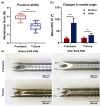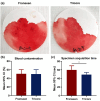Comparison of Franseen and novel tricore needles for endoscopic ultrasound-guided fine-needle biopsy in a porcine liver model
- PMID: 39341878
- PMCID: PMC11439050
- DOI: 10.1038/s41598-024-73184-3
Comparison of Franseen and novel tricore needles for endoscopic ultrasound-guided fine-needle biopsy in a porcine liver model
Abstract
Endoscopic ultrasound-guided fine needle biopsy is an effective method for obtaining tissue samples from various organs; however, challenges such as inadequate specimens persist. This study compared a newly designed Tricore needle with a Franseen needle for endoscopic ultrasound-guided fine needle biopsy of porcine liver. Both needles were tested on four male Yorkshire pigs. Specimens were obtained with an 100% (36/36) success rate with no procedure-related adverse effects. The Tricore needle experienced significantly less resistance during puncture than Franseen needle (3.83 vs. 5.97 N, P < 0.001) and better ultrasound visibility (168.97 vs. 125.04, P = 0.004). The Tricore needle also achieved faster specimen acquisition time (48.94 vs. 59.90 s, P = 0.038), larger total specimen area (6.67 vs. 4.68 mm2, P = 0.049), fewer fragments (23.94 vs. 31.94, P = 0.190), lager fragment area (0.28 vs. 0.15 mm2, P < 0.001), and more the number of complete portal tracts (15.44 vs. 9.33, P = 0.017) compared to the Franseen needle. The newly designed Tricore needle showed enhanced procedural performance and specimen quantity and quality compared to commercially available Franseen needle. Although further clinical studies are required, the Tricore needle may represent a favorable option for endoscopic ultrasound-guided fine-needle biopsy procedures.
Keywords: Animal model; Endoscopic ultrasonography; Fine-needle biopsy; Image-guided biopsy; Liver.
© 2024. The Author(s).
Conflict of interest statement
The authors declare no competing interests.
Figures





Similar articles
-
Comparison of Two Specialized Histology Needles for Endoscopic Ultrasound (EUS)-Guided Liver Biopsy: A Pilot Study.Dig Dis Sci. 2021 May;66(5):1700-1706. doi: 10.1007/s10620-020-06391-3. Epub 2020 Jun 17. Dig Dis Sci. 2021. PMID: 32556821
-
A prospective study on the histological evaluation of type 1 autoimmune pancreatitis using endoscopic ultrasound-guided fine needle biopsy with a 19-gauge Franseen needle.J Hepatobiliary Pancreat Sci. 2024 Aug;31(8):581-590. doi: 10.1002/jhbp.1438. Epub 2024 May 8. J Hepatobiliary Pancreat Sci. 2024. PMID: 38716862
-
Surface area outcomes in EUS-guided liver biopsy: a comparative study of Franseen and Fork-tip needles.BMC Gastroenterol. 2025 May 14;25(1):370. doi: 10.1186/s12876-025-03961-5. BMC Gastroenterol. 2025. PMID: 40369417 Free PMC article.
-
Performance of endoscopic ultrasound-guided fine-needle aspiration (EUS-FNA) needles. How to handle specimens?Minerva Med. 2014 Oct;105(5):323-31. Epub 2014 Jul 6. Minerva Med. 2014. PMID: 25028866 Review. No abstract available.
-
Techniques for endoscopic ultrasound-guided fine-needle biopsy.Gastrointest Endosc Clin N Am. 2014 Jan;24(1):83-107. doi: 10.1016/j.giec.2013.08.010. Gastrointest Endosc Clin N Am. 2014. PMID: 24215762 Review.
References
-
- Song, T. J. et al. The prospective randomized, controlled trial of endoscopic ultrasound-guided fine-needle aspiration using 22G and 19G aspiration needles for solid pancreatic or peripancreatic masses. Am. J. Gastroenterol.105, 1739–1745. 10.1038/ajg.2010.108 (2010). - PubMed
Publication types
MeSH terms
Grants and funding
LinkOut - more resources
Full Text Sources

